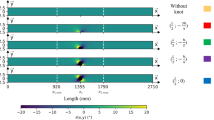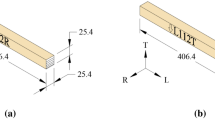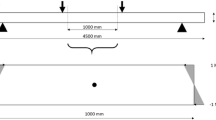Abstract
The influence of different types of knots and fiber deviations on the bending of wood, as managed using visual grading standards, was analytically discussed in this research by means of the finite element method. The effect of each geometrical variable on the strength and stress distribution has been studied individually. This was accomplished after validating a previously presented finite element model that accounted for the three-dimensional shape of the knots and fiber deviations. The simulated sizes and positions were those commonly managed by the standards for strength grading. The research presents the effect of: (1) the size and position of cylindrical face knots; (2) size and position of truncated conical face knots; (3) size and position of shallow conical face knots; (4) size and position of conical edge knots; (5) inclination of face knots. In each case, the analytical predictions of the modulus of rupture and stress distribution are detailed. Seven characteristic positions with distinct mechanical behavior were found, which should be accounted for in order to improve the wood grading efficiency.








Similar content being viewed by others
References
Argüelles B (1994) Prediction of the behavior of wooden pieces by animated simulation. Dissertation (in Spanish), Polytechnic University of Madrid, Madrid
Argüelles A, Arriaga F (1996) Estimation and design of wooden structures (in Spanish). AITIM, Madrid
Baño V (2009) Numerical analysis of wood strength loss due to the presence of knots. Dissertation (in Spanish), University of Santiago de Compostela, Lugo
Boström L (1992) Method for determination of the softening behavior of wood and the applicability of a non linear fracture mechanics model. Dissertation, Lund University, Lund
Cramer M, Goodman JR (1983) Model for stress analysis and strength prediction of lumber. Wood Fiber Sci 15(4):338–349
Foley C (2001) A three-dimensional paradigm of fiber orientation in timber. Wood Sci Technol 35:453–465
Grekin M (2006) Nordic Scots pine vs. selected competing species and non-wood substitute materials in mechanical wood products—literature survey. Working papers of the Finnish Forest Research Institute 36, Finnish Forest Research Institute, Finland
Guindos P, Guaita M (2013) A three-dimensional wood material model to simulate the behavior of wood with any type of knot at the macro-scale. Wood Sci Technol 47(3):585–599
Hashin Z (1980) Failure criteria for unidirectional fiber composites. J ApplMech 47:329–334
Hill R (1947) A theory of the yielding and plastic flow of anisotropic metals. Proc R Soc Lond A 193:281–297
Hoffman O (1967) The brittle strength of orthotropic materials. J Compos Mater 1:200–206
Kasal B, Leichti RJ (2005) State of the art in multiaxial phenomenological failure criteria for wood members. Prog Struct Eng Mater 7(1):3–13
Landelius J (1989) Finite area method. Report TVSM 5043, Division of Structural Mechanics, Lund University, Lund
Liu JY (1984) Evaluation of the tensor polynomial strength theory for wood. J Compos Mater 18(3):216–226
Masuda M (1988) Theoretical consideration on fracture criteria of wood—proposal of a finite small area theory. In: Proceedings of the WCTE 1988, Seattle, vol 2, pp 584–595
Masuda M, Honda R (1994) Theoretical analysis on bending of lumber containing knots by using finite element method. MokuzaiGakkaishi 40:127–133
Mihashi H, Navi P, Sunderland H, Itagaki N, Ninomiya S (1999) Micromechanics of knot’s influence on tensile strength of Japanese cedar. In: Proceedings of first Rilem symposium on timber engineering, Stockholm, pp 181–190
Nahas MN (1986) Survey of failure and post-failure theories of laminated fiber-reinforced composites. J Compos Technol Res 8(4):138–153
Niskanen M, Silven O(2007) Machine vision based lumber grain measurement. In: MVA2007 IAPR conference on machine vision applications, Tokyo, pp 408–411
Norris CB (1962) Strength of orthotropic materials subjected to combined stresses. US Forest Products Laboratory, Report No. 1816, Madison
Pellicane PJ, Franco N (1994) Modeling wood pole failure. Part 2: material and geometric considerations. Wood Sci Technol 28:261–274
Phillips GE, Bodig J, Goodman JR (1981) Flow grain analogy. Wood Sci 14:55–64
INSTA 142 (2009) Nordic visual strength grading rules for timber
Saravi A, Lawrence PD, Lam F (2004) Implementation of a mechanics-based system for estimating the strength of timber. IEEE Trans Instrum Meas 53(2):284–292
Shen J, Shajer G, Parker R (1994) Theory and practice in measuring wood grain angle using microwaves. IEEE Trans Instrum Meas 43(6):803–809
Shih CF, Lee D (1978) Further developments in anisotropic plasticity. J Eng Mater 100:294–302
Thelandersson S, Larsen HJ (2003) Timber engineering. Wiley, UK
Tsai SW (1965) Strength characteristics of composite materials. NASA report no. CR-224, Washington DC
Tsai SW, Azzi VD (1966) Strength of laminated composite materials. AIAA J 4(2):296–301
Tsai SW, Wu EM (1971) A general theory of strength for anisotropic materials. J Compos Mater 5(1):58–80
UNE 56544 (2011) Visual grading for structural sawn timber. Coniferous timber
Valliappan S, Boonlaulohr P, Lee IK (1976) Non-linear analysis for anisotropic materials. Int J Numer Methods Eng 10:597–606
Yamada SE, Sun CT (1978) Analysis of laminate strength and its distribution. J Compos Mater 12:275–284
Zandenbergs JG, Smith FW (1988) Finite element fracture prediction for wood with knots and cross grain. Wood Fiber Sci 20(1):97–106
Acknowledgments
The authors are very grateful to both the Spanish Ministry of Education for its financial support through the National training program of University lecturers (FPU) and the Barrie de la Maza foundation for its postdoctoral research program.
Author information
Authors and Affiliations
Corresponding author
Rights and permissions
About this article
Cite this article
Guindos, P., Guaita, M. The analytical influence of all types of knots on bending. Wood Sci Technol 48, 533–552 (2014). https://doi.org/10.1007/s00226-014-0621-8
Received:
Published:
Issue Date:
DOI: https://doi.org/10.1007/s00226-014-0621-8




